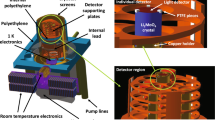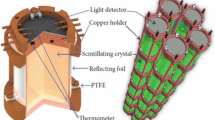Abstract
The only naturally occurring isotope of bismuth, 209Bi, is commonly regarded as the heaviest stable isotope. But like most other heavy nuclei abundant in nature and characterized by an exceptionally long lifetime, it is metastable with respect to α-decay1. However, the decay usually evades observation because the nuclear structure2,3 of 209Bi gives rise to an extremely low decay probability and, moreover, generates low-energy α-particles difficult to detect. Indeed, dedicated experiments2,3,4,5,6 attempting to record the α-decay of 209Bi in nuclear emulsions failed. However, scintillating bolometers7,8,9 operated at temperatures below 100 mK offer improved detection efficiency and sensitivity, whereas a broad palette of targets could be available10. Here we report the successful use of this method for the unambiguous detection of 209Bi α-decay in bismuth germanate detectors cooled to 20 mK. We measure an energy release of 3,137 ± 1 (statistical) ± 2 (systematic) keV and a half-life of (1.9 ± 0.2) × 1019 yr, which are in agreement with expected values.



Similar content being viewed by others
References
Audi, G., Bersillon, O., Blachot, J. & Wapstra, A. H. The Nubase evaluation of nuclear and decay properties. Nucl. Phys. A 624, 1–124 (1997)
Hincks, E. P., Millar, C. H. & Hanna, G. C. A search for α-particles from the decay of 209Bi. Can. J. Phys. 36, 231–251 (1958)
de Carvalho, H. G. & de Araújo Penna, M. Alpha-activity of 209Bi. Lett. Nuovo Cim. 3, 720–722 (1972)
Jenkner, K. & Broda, E. Some upper limits of possible alpha-activity. Nature 164, 412–413 (1949)
Faraggi, H. & Berthelot, A. Sur la radioactivité alpha du bismuth naturel. C. R. Acad. Sci. 232, 2093–2095 (1951)
Riezler, W. & Porschen, W. Natürliche Radioaktivität von Wismut. Z. Naturforsch 7a, 634–635 (1952)
Gonzalez-Mestres, L. & Perret-Gallix, D. Detection of low energy solar neutrinos and galactic dark matter with crystal scintillators. Nucl. Instrum. Meth. A 279, 382–387 (1989)
Bobin, C. et al. Alpha/gamma discrimination with a CaF2(Eu) target bolometer optically coupled to a composite infrared bolometer. Nucl. Instrum. Meth. A 386, 453–457 (1997)
Alessandrello, A. et al. Development of a thermal scintillating detector for double beta decay of 48Ca. Nucl. Phys. B (Proc. Suppl.) 28A, 233–235 (1992)
Moses, W. W. et al. Prospects for dense, infrared emitting scintillators. IEEE Trans. Nucl. Sci. 45 (3), 462–466 (1998)
Ziegler, J. F. The Stopping and Ranges of Ions in Matter Vol. 4, Helium: Stopping Powers and Ranges in All Elemental Matter (Pergamon, New York, 1977)
Coron, N. et al. A composite bolometer as a charged-particle spectrometer. Nature 314, 75–76 (1985)
Cebrián, S. et al. The ROSEBUD experiment at Canfranc: 2001 report. Nucl. Phys. B (Proc. Suppl.) 110, 97–99 (2002)
Zhou, J. W. et al. Advances towards fast thermal detectors of intermediate mass with high resolution and large dynamic range. Nucl. Instrum. Meth. A 335, 443–452 (1993)
Alessandrello, A. et al. Preliminary results on the performance of a TeO2 thermal detector in a search for direct interactions of WIMPs. Phys. Lett. B 384, 316–322 (1996)
Rasmussen, J. O. Alpha-decay barrier penetrabilities with an exponential nuclear potential: even-even nuclei. Phys. Rev. 113, 1593–1598 (1959)
Rasmussen, J. O. Alpha-decay barrier penetrabilities with an exponential nuclear potential: odd-mass nuclei. Phys. Rev. 115, 1675–1679 (1959)
Zhou, T. Q., Tan, H. R., He, C. F., Zhu, R. Y. & Newman, H. B. Determination of trace elements in BGO by neutron activation analysis. Nucl. Instrum. Meth. A 258, 58–66 (1987)
Barnes, R. G. L., Sims, R., Rousseau, M. D. & Sproston, M. Bismuth germanate (BGO) optimisation for energy resolution and purity. IEEE Trans. Nucl. Sci. 31, 249–252 (1984)
Norman, E. B. et al. Diamonds, maybe, but bismuth is not forever. Bull. Am. Phys. Soc. 45, 30 (2000)
Giannatiempo, A. & Perego, A. Penetration effects in the internal conversion process of the 204 KeV transition in 205Tl. Z. Phys. A 308, 247–251 (1982)
Cebrián, S. et al. Improved limits for natural α radioactivity of tungsten with a CaWO4 scintillating bolometer. Phys. Lett. B 556, 14–20 (2003)
Tretyak, V. I. & Zdesenko, Y. G. Tables of double beta decay data—an update. Atom. Data Nucl. Data Tables 80, 83–116 (2002)
DeBraeckeleer, L. et al. Measurement of lifetime of 209Bi and test of the exponential decay law. TUNL Progr. Rep. 37, 94 (1998)
DeBraeckeleer, L., Gould, C. R. & Tornow, W. Search for T1/2 of the “stable” nucleus 209Bi. TUNL Progr. Rep. 38, 87–89 (1999)
Powell, C. F., Fowler, P. H. & Perkins, D. H. The Study of Elementary Particles by the Photographic Method. An Account of the Principal Techniques and Discoveries Illustrated by an Atlas of Photomicrographs 137–138, 644–645 (Pergamon, New York, 1959)
Firestone, R. B. Table of Isotopes, 8th edn, Vol. II: A = 151–272 (eds Shirley, V. S., Baglin, C. M., Chu, S. Y. F. & Zipkin, J.) 2545, 2595 (Wiley, New York, 1996)
Acknowledgements
This work is supported by the R&D programme from CNRS/INSU, and by BNM for the high-resolution α-spectrometry part. The design of the optical detectors results from years of support by CNES. P. Pari from CEA/SPEC designed our dilution refrigerator. We thank the SEMIRAMIS members of CSNSM for their accurate implantation, as well as F. Jomard for SIMS analysis, G. Audi for discussions, E. Leblanc from LNHB/BNM for independent calibration source measurements, and I. Rameau and Y. Bouvÿ for their support and comments.
Author information
Authors and Affiliations
Corresponding author
Ethics declarations
Competing interests
The authors declare that they have no competing financial interests.
Supplementary information
Rights and permissions
About this article
Cite this article
de Marcillac, P., Coron, N., Dambier, G. et al. Experimental detection of α-particles from the radioactive decay of natural bismuth. Nature 422, 876–878 (2003). https://doi.org/10.1038/nature01541
Received:
Accepted:
Issue Date:
DOI: https://doi.org/10.1038/nature01541
- Springer Nature Limited
This article is cited by
-
Composition design for modified nickel nanopastes containing a low-melting element as additive for pressureless nanojoining
Welding in the World (2024)
-
Technical opportunities and challenges in developing total-body PET scanners for mice and rats
EJNMMI Physics (2023)
-
Bi-HPDO3A as a novel contrast agent for X-ray computed tomography
Scientific Reports (2023)
-
Experimental evidence of a size-dependent sign change of the Seebeck coefficient of Bi nanowire arrays
Scientific Reports (2023)
-
Alpha decay investigations of Bi isotopes
Indian Journal of Physics (2023)





